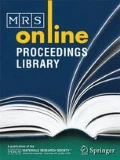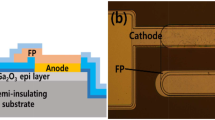Abstract
As millisecond annealing is increasingly utilized, the as-implanted profile dominates the final dopant distribution. We characterized boron diffusion in amorphous silicon prior to post-implantation annealing. SIMS confirmed that both fluorine and germanium enhance boron motion in amorphous materials. The magnitude of boron diffusion in germanium amorphized silicon scales with increasing fluorine dose. Boron atoms are mobile at concentrations approaching 1x1019 atoms/cm3. It appears that defects inherent to the structure of amorphous silicon can trap and immobilize boron atoms at room temperature, but that chemical reactions involving Si-F and Si-Ge eliminate potential trapping sites. Sequential Ge+, F+, and B+ implants result in 80% more boron motion than do sequential Si+, F+, and B+ implants. The mobile boron dose and trapping site concentration change as functions of the fluorine dose through power law relationships. As the fluorine dose increases, the trapping site population decreases and the mobile boron dose increases. This reduction in trap density can result in as-implanted “junction depths” that are as much as 75% deeper (taken at 1x1018 atoms/cm-3) for samples implanted with 500 eV, 1x1015 atoms/cm2 boron.
Similar content being viewed by others
References
S. Baek, T. Jang, and H. Hwang, Appl. Phys. Lett. 80 (13), 2272 (2002).
G. Fortunato, L. Mariucci, M. Stanizzi, V. Privitera, S. Whelan, C. Spinella, G. Mannino, M. Italia, C. Bongiorno, and A. Mittiga, Nucl. Inst. Meth. Phys. Res. B 186, 401 (2002).
T. Gebel, M. Voelskow, W. Skorupa, G. Mannino, V. Privitera, F. Priolo, E. Napolitani, and A. Carnera, Nucl. Inst. Meth. Phys. Res. B 186, 287 (2002).
H. Tsukamoto, Solid-State Electron. 43, 487 (1999).
M.H. Juang, F.S. Wan, H.W. Liu, K.L. Cheng, and H.C. Cheng, J. Appl. Phys. 71 (7), 3628 (1992).
M.H. Juang and H.C. Cheng, Appl. Phys. Lett. 60 (17), 2092 (1992).
E. Napolitani, A. Coati, D. De Salvador, A. Carnera, S. Mirabella, S. Scalese, and F. Priolo, Appl. Phys. Lett. 79 (25), 4145 (2001).
V. Privitera, C. Spinella, G. Fortunato, and L. Mariucci, Appl. Phys. Lett. 77 (4), 552 (2000).
J.M. Jacques, K.S. Jones, L.S. Robertson, A. Li-Fatou, C.M. Hazelton, E. Napolitani, and L.M. Rubin, J. Appl. Phys. 98, 073521 (2005).
J.M. Jacques, L.S. Robertson, M.E. Law, K.S. Jones, M.J. Rendon, and J. Bennett, Mater. Res. Soc. Symp. Proc. 717, C4.6.1 (2002).
E. Napolitani, D. De Salvador, R. Storti, A. Carnera, S. Mirabella, F. Priolo, Phys. Rev. Lett. 93, 055901 (2004).
J.F. Ziegler and J.P. Biersack, The Stopping and Range of Ions in Matter (SRIM-2000.4) (IBM Co., Maryland, 1999).
S. Roorda, Ph.D. Thesis (1990). Relaxation and Crystallization of Amorphous Silicon. The Rijksuniversiteit, Utrecht, The Netherlands.
S. Roorda, J.M. Poate, D.C. Jacobson, B.S. Dennis, S. Dierker, and W.C. Sinke, Appl. Phys. Lett. 56 (21), 2097 (1990).
S. Roorda, W.C. Sinke, J.M. Poate, D.C. Jacobson, S. Dierker, B.S. Dennis, D.J. Eaglesham, F. Spaepen, and P. Fuoss, Phys. Rev. B 44 (8), 3702 (1991).
S. Roorda, Nucl. Inst. & Meth. Phys. Res. B 148, 366 (1999).
G. Hobler, A. Simionescu, L. Palmetshofer, C. Tian, and G. Stingeder, J. Appl. Phys. 77, 3697 (1995).
G. Hobler and G. Otto, Mater. Sci. Semicond. Process. 6, 1 (2003).
Ion Implantation Science and Technology, 2004 ed., edited by J. F. Ziegler (Ion Implantation Technology Co., New York, 2004) pp. 5-8--5-10.
W.G. Spitzer, G.K. Huber, and T.A. Kennedy, Nucl. Inst. Meth. 209/210, 309 (1983).
M.H. Brodsky and D. Kaplan, J. Non-Cryst. Solids 32, 431 (1979).
D. Kalpan, N. Sol, G. Velasco, and P. Thomas, Appl. Phys. Lett. 33, 440 (1978).
S. Dannefaer, P. Mascher, and D. Kerr, Phys. Rev. Lett. 56, 2195 (1986).
E.J.H. Collart, K. Weemers, N.E.B. Cowern, J. Politiek, P.H.L. Bancken, J.G.M. van Berkum, and D.J. Gravesteijn, Nucl. Inst. Meth. Phys. Res. B 139, 98 (1998).
N.E.B. Cowern, Appl. Phys. Lett. 64 (20), 2646 (1994).
Author information
Authors and Affiliations
Rights and permissions
About this article
Cite this article
Jacques, J.M., Jones, K.S., Law, M.E. et al. Room Temperature Boron Diffusion in Amorphous Silicon. MRS Online Proceedings Library 912, 201 (2005). https://doi.org/10.1557/PROC-0912-C02-01
Received:
Accepted:
Published:
DOI: https://doi.org/10.1557/PROC-0912-C02-01




